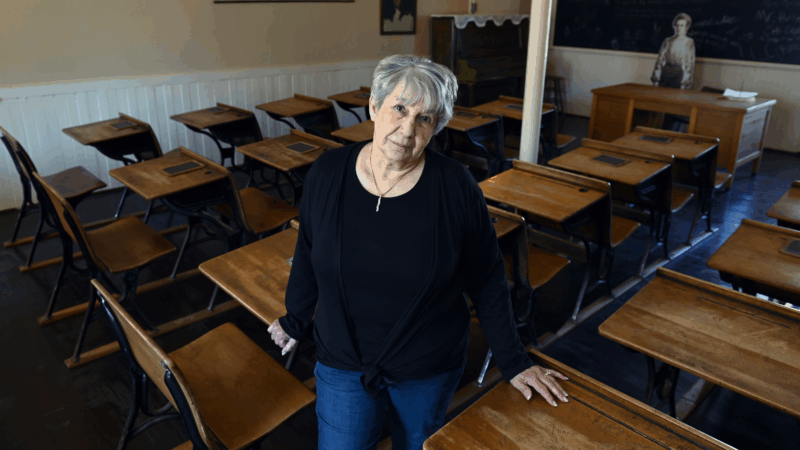‘We survived, we are resilient’: Remembering U.S. Indian boarding schools
“When I went to boarding school, I was 7,” said Ramona Klein, speaking to a group clad in orange shirts at a vigil earlier this month in Washington, D.C. “My parents didn’t see me — other than a little while during the summer — for four years. Some parents didn’t see their children for 12 years.”
Klein attended the Fort Totten Indian Industrial School in North Dakota from 1954 to 1958. She said being cut off from her family was just one of the many hardships she faced as a student at a federal Indian boarding school, in addition to abuse and neglect.
She and many others will be marking Orange Shirt Day at events around the country on Tuesday, in remembrance of the tens of thousands of Native children who attended these schools, the goal of which was to “kill the Indian … save the man.”
The day of memorial is marked in Canada each year on Sept. 30, where it is formally known as the National Day for Truth and Reconciliation, and is increasingly observed in communities in the United States.
Klein spoke earlier this month at the vigil at the Indian Gaming Association conference center near Capitol Hill.
There, organizers from the National Native American Boarding School Healing Coalition passed out orange T-shirts that read “Every Child Matters.” Klein, a citizen of the Turtle Mountain Band of Chippewa Indians, is the group’s vice president.
From 1819 to 1969, the federal government financed more than 400 Indian boarding schools. Native children were often forcibly removed from their homes and sent to these schools, sometimes hundreds of miles away, where many were abused and neglected.
An investigation by the Interior Department found that, of more than 60,000 students who attended the federal Indian boarding schools, at least 973 American Indian, Alaska Native and Native Hawaiian children died.
“There was physical abuse, sexual abuse, emotional abuse, academic abuse, intellectual abuse and neglect,” Klein said. “If I didn’t start healing, it would impact my children and my grandchildren.”
The orange shirts honor Phyllis Webstad of the Stswecem’c Xget’tem First Nation, who attended a Canadian boarding school as a child. She now lectures and writes about the experience, including her story of how a bright orange shirt her grandmother had bought for her to wear at her new school was taken away on her first day.
For current Indigenous students, honoring Orange Shirt Day is seen as a way of recognizing and correcting how education has been used as a weapon against Native children.
“This was a genocide. We survived, we are resilient,” said Nani Mahkuk-Guaman, a student leader at the University of Minnesota Morris. A building on the campus was part of a federal Indian boarding school from 1887-1909.
The observances at that location, she said, are a way of “creating happy memories in a place where students didn’t experience happiness.”‘
Honoring boarding school survivors “is a way for us to heal,” said Mahkuk-Guaman, 21, a descendant of the Menominee Tribe of Wisconsin and the Winnebago Tribe of Nebraska. “And to help us understand what our parents, grandparents — all of our relatives — went through.” Several members of her family attended boarding schools.
The horrors experienced in the boarding schools in the U.S. were for decades hidden or seldom acknowledged. Only recently, beginning in 2022, has the federal government accepted responsibility for its role.
Some survivors have been reluctant to share what happened to them, even with close family.
But Klein and others believe it is important to talk about their experiences, before it’s too late.
“If we don’t remember what happened, it’s going to get lost,” said Klein, 78. “I’m closer to the end of life than the beginning of life, so I have to get busy. I have to stay busy so that it’s not forgotten. … We remember all of the survivors, all of the kids who didn’t go home.”
Auburn tabs USF’s Alex Golesh as its next coach, replacing Hugh Freeze on the Plains
The 41-year-old Golesh, who was born in Russia and moved to the United State at age 7, is signing a six-year contract that averages more than $7 million annually to replace Hugh Freeze. Freeze was fired in early November after failing to fix Auburn’s offensive issues in three seasons on the Plains.
Alabama Power seeks to delay rate hike for new gas plant amid outcry
The state’s largest utility has proposed delaying the rate increase from its purchase of a $622 million natural gas plant until 2028.
Former U.S. Sen. Doug Jones announces run for Alabama governor
Jones announced his campaign Monday afternoon, hours after filing campaign paperwork with the Secretary of State's Office. His gubernatorial bid could set up a rematch with U.S. Sen. Tommy Tuberville, the Republican who defeated Jones in 2020 and is now running for governor.
Scorching Saturdays: The rising heat threat inside football stadiums
Excessive heat and more frequent medical incidents in Southern college football stadiums could be a warning sign for universities across the country.
The Gulf States Newsroom is hiring an Audio Editor
The Gulf States Newsroom is hiring an Audio Editor to join our award-winning team covering important regional stories across Mississippi, Alabama and Louisiana.
Judge orders new Alabama Senate map after ruling found racial gerrymandering
U.S. District Judge Anna Manasco, appointed by President Donald Trump during his first term, issued the ruling Monday putting a new court-selected map in place for the 2026 and 2030 elections.









